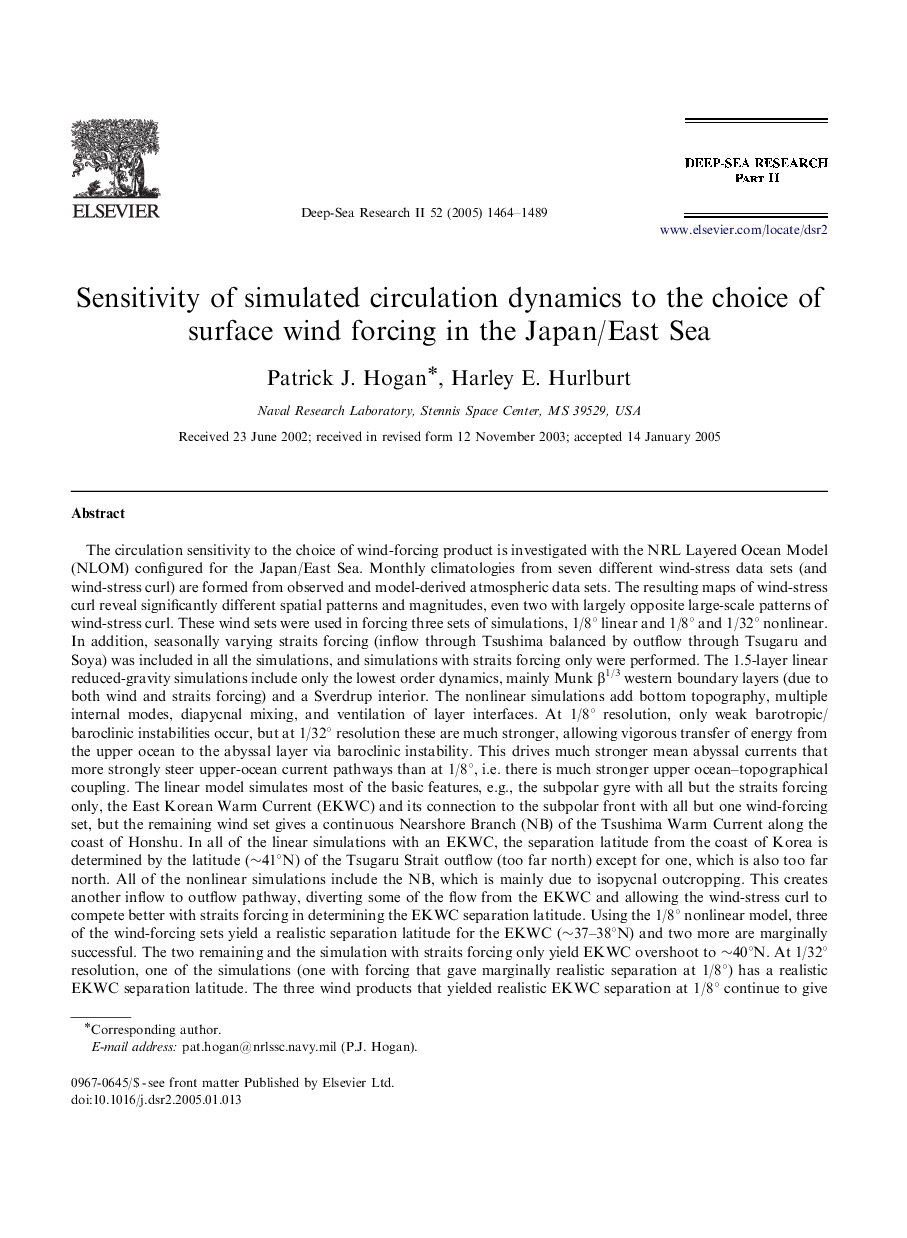| کد مقاله | کد نشریه | سال انتشار | مقاله انگلیسی | نسخه تمام متن |
|---|---|---|---|---|
| 9480085 | 1626525 | 2005 | 26 صفحه PDF | دانلود رایگان |
عنوان انگلیسی مقاله ISI
Sensitivity of simulated circulation dynamics to the choice of surface wind forcing in the Japan/East Sea
دانلود مقاله + سفارش ترجمه
دانلود مقاله ISI انگلیسی
رایگان برای ایرانیان
موضوعات مرتبط
مهندسی و علوم پایه
علوم زمین و سیارات
زمین شناسی
پیش نمایش صفحه اول مقاله

چکیده انگلیسی
The circulation sensitivity to the choice of wind-forcing product is investigated with the NRL Layered Ocean Model (NLOM) configured for the Japan/East Sea. Monthly climatologies from seven different wind-stress data sets (and wind-stress curl) are formed from observed and model-derived atmospheric data sets. The resulting maps of wind-stress curl reveal significantly different spatial patterns and magnitudes, even two with largely opposite large-scale patterns of wind-stress curl. These wind sets were used in forcing three sets of simulations, 1/8° linear and 1/8° and 1/32° nonlinear. In addition, seasonally varying straits forcing (inflow through Tsushima balanced by outflow through Tsugaru and Soya) was included in all the simulations, and simulations with straits forcing only were performed. The 1.5-layer linear reduced-gravity simulations include only the lowest order dynamics, mainly Munk β1/3 western boundary layers (due to both wind and straits forcing) and a Sverdrup interior. The nonlinear simulations add bottom topography, multiple internal modes, diapycnal mixing, and ventilation of layer interfaces. At 1/8° resolution, only weak barotropic/baroclinic instabilities occur, but at 1/32° resolution these are much stronger, allowing vigorous transfer of energy from the upper ocean to the abyssal layer via baroclinic instability. This drives much stronger mean abyssal currents that more strongly steer upper-ocean current pathways than at 1/8°, i.e. there is much stronger upper ocean-topographical coupling. The linear model simulates most of the basic features, e.g., the subpolar gyre with all but the straits forcing only, the East Korean Warm Current (EKWC) and its connection to the subpolar front with all but one wind-forcing set, but the remaining wind set gives a continuous Nearshore Branch (NB) of the Tsushima Warm Current along the coast of Honshu. In all of the linear simulations with an EKWC, the separation latitude from the coast of Korea is determined by the latitude (â¼41°N) of the Tsugaru Strait outflow (too far north) except for one, which is also too far north. All of the nonlinear simulations include the NB, which is mainly due to isopycnal outcropping. This creates another inflow to outflow pathway, diverting some of the flow from the EKWC and allowing the wind-stress curl to compete better with straits forcing in determining the EKWC separation latitude. Using the 1/8° nonlinear model, three of the wind-forcing sets yield a realistic separation latitude for the EKWC (â¼37-38°N) and two more are marginally successful. The two remaining and the simulation with straits forcing only yield EKWC overshoot to â¼40°N. At 1/32° resolution, one of the simulations (one with forcing that gave marginally realistic separation at 1/8°) has a realistic EKWC separation latitude. The three wind products that yielded realistic EKWC separation at 1/8° continue to give realistic separation at 1/32° via the wind-stress curl, but the remainder give realistic separation via upper ocean-topographical coupling. At 1/32° resolution all but one of the simulations showed a strong Yamato Rise impact on the pathway of the subpolar front due to steering by abyssal currents. At 1/8° resolution only two of the eight showed any such impact, one due to abyssal currents driven by vertical mixing in the subpolar gyre. In all the other 1/8° simulations the mean abyssal currents were weak, but in one case weak abyssal currents were aided by a region of strong negative wind-stress curl not seen in the other wind products. In addition, regions of the ventilation of intermediate and deep water in response to each wind set are identified. A series of six 1/32° simulations forced interannually with 6-hourly winds 1979-93 are used to separate the model variability due to wind forcing (deterministic) and flow instabilities (nondeterministic). This analysis indicates that flow instabilities are the dominant source of SSH variability over a large majority of the basin, especially near 37-38°N, where the EKWC separates from the coast, and along the pathway of the subpolar front following the north rim of the Yamato Rise towards the Tsugaru Strait. Wind forcing dominates the SSH variability in the coastal wave guide and over the deep basins and troughs.
ناشر
Database: Elsevier - ScienceDirect (ساینس دایرکت)
Journal: Deep Sea Research Part II: Topical Studies in Oceanography - Volume 52, Issues 11â13, June 2005, Pages 1464-1489
Journal: Deep Sea Research Part II: Topical Studies in Oceanography - Volume 52, Issues 11â13, June 2005, Pages 1464-1489
نویسندگان
Patrick J. Hogan, Harley E. Hurlburt,